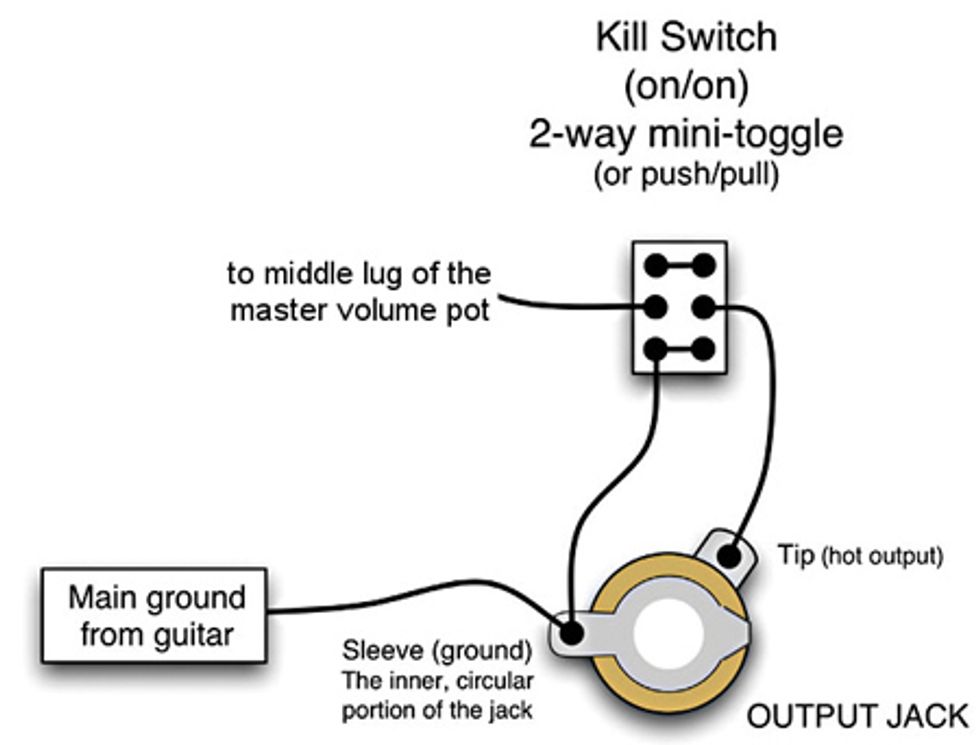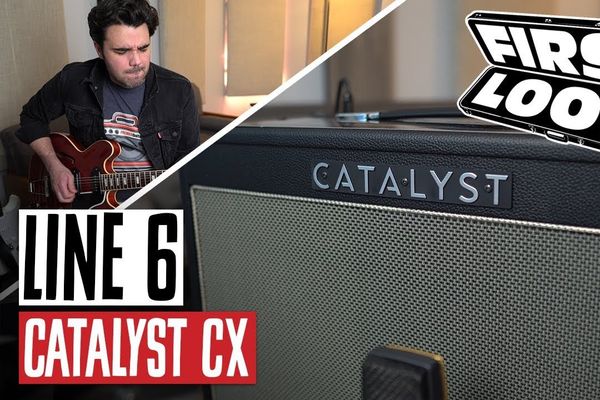How to install the kill switch made famous by EVH, Buckethead and many others
Hello and welcome back to “Mod Garage." Inspired by a recent press release, I'm going to show you the basics of the so-called “kill switch" for a Strat. I'm sure you've seen this on YouTube: a cool, long-haired guitarist reaches for the pickup selector switch on his Les Paul (which is hanging at hip height), and while playing he starts to wiggle it back and forth to create a stuttering or staccato on/off sound, the so-called “machine gun" sound— naturally with tons of gain on it. How's he doing that? It's easy on any guitar with individual volume controls for the pickups: turn down the volume pot for the neck pickup, play the bridge pickup and use the 3-way selector toggle to flick between the now quiet neck and the roaring bridge pickup. Ever tried this with a standard Strat? If so, I'm pretty sure you were disappointed with the results. It's time to have a closer look at the kill switch and what it's doing.
In a nutshell, a guitar kill switch is pretty much the same as the well-known standby switch on your tube amp. It's doing what you'd expect from the name: cutting the signal. The difference is that a tube amp's standby switch cuts the signal while the rest of your gear is engaged and waiting to be played, while the kill switch is a momentary interruption of the signal. So what's the benefit of a kill switch?
There are at least two good reasons for having one in a guitar:
1. As we just discovered, you can use such a switch to create the staccato effect called the “machine-gun" sound. Some well-known players to use this effect include Eddie Van Halen and Buckethead. It's commonly used with lots of gain, but when you're playing clean, you can use the kill switch to make a held chord sound as though the guitar were being strummed.
2. When you play with lots of gain, you can simply use the kill switch to shut down the entire guitar during a break, without altering your controls, saving your audience from noise and hiss. This is also a really good option when using your guitar in the studio. Some companies offer a kill switch option for their guitars. My friend Heiko from the German company Basslab (basslab.de) even has this option as a standard in all of his guitars. Shadow Electronics (shadow-electronics. com) released a special “Kill Pot" some time ago, which is basically a normal pot with an integrated momentary push switch.
Integrating a kill switch in a standard Strat circuit is very easy, but there's a catch. I've seen countless forum threads on this subject, and most go something like this: “all you have to do is to interrupt the signal going to the output jack, route it via a normal on/off switch, and you're done!" This must be one of the basic mods from the popular Obnoxious Modding Guide. If you do it this way, you will get the annoying and all-too-familiar buzz and noise of an accidentally unplugged guitar— which is fine only if you're trying to mimic the sound of a UFO landing. Remember the first basic rule we discussed several months ago: never disconnect the signal! If you want to shut down the signal, shorting it to ground is the way to go; your rig will go quiet without any buzzing noises. When playing clean, cutting the signal almost always results in a popping noise. However, if you're distorting the signal, it will clip it anyway, so this won't be nearly as noticeable. There's nothing wrong with the wiring, it's just the physics of the situation. This mod sounds best with a heavy, overdriven signal anyway, so it works just fine for most players.
Let's Get Started
This month I'll show you how to set up a kill switch with a 2PDT (on/on) or push/pull or push/push pot with an integrated 2PDT switch. Next month, I'll show you how to set up a momentary kill switch on a Strat. This requires a deeper look into the switching functions of such switches, but it's worth the effort.
Wiring diagram courtesy of Seymour Duncan Pickups and used by permission. Seymour Duncan and the stylized S are registered trademarks of Seymour Duncan Pickups, with which Premier Guitar magazine is not affiliated.
Solder the two jumper connections on the top and on the bottom of the switch as shown in the diagram. Now solder the two wires to the middle lug of the Strat's master volume control and to the tip (hot output) of the output jack. Congratulations, that's it. Now you can machine-gun with your Strat. Stay tuned for more next month. Until then ... keep on modding!
Dirk Wacker
Dirk Wacker lives in Germany and has been addicted to all kinds of guitars since the age of five. He is fascinated by anything that has something to do with old Fender guitars and amps. He hates short scales and Telecaster neck pickups, but loves twang. In his spare time he plays country, rockabilly, surf and Nashville styles in two bands, works as a studio musician for a local studio and writes for several guitar mags. He is also a hardcore DIY guy for guitars, amps and stompboxes and runs an extensive webpage www.singlecoil.com about these things.


